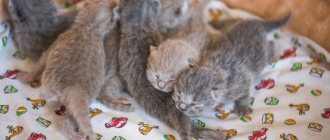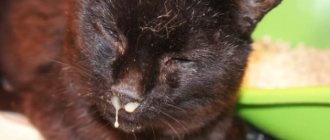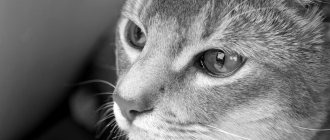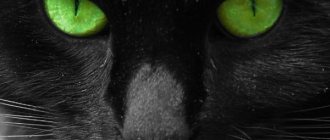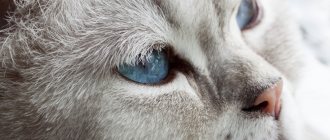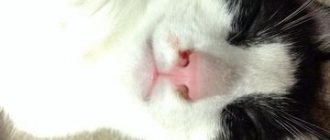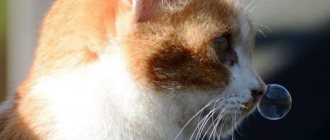There is no single standard that defines the health of a cat's nose. Whether it’s color, dryness or moisture, roughness or smoothness, there are no clear signs of pathology or well-being. All representatives of felines have different noses; moreover, the color of the nose of the same cat can change within certain limits several times a day. However, there is a list of general signs that allow you to determine what kind of nose a healthy cat should have.
What kind of nose should a healthy cat have?
How does a cat's nose work?
A cat's nose is not very different in structure from the human nose. It includes two nasal canals, which are separated by cartilage. When a cat sucks in air, it enters the so-called “nasal chambers.” From the chambers, the air enters winding channels, in which it spends quite a long time, during which the cat recognizes the nature of the smell and reads its information. It is in these labyrinths of channels that the smell is cleared of other impurities that make it difficult to identify the scent of interest to the four-legged predator.
Cat's olfactory system
At the end of this maze, the molecules that enter the cat's nose interact with odor-sensitive cells responsible for recognition. These analytical cells are connected to the olfactory center of the cat's brain, which is responsible for diagnosing all aromas.
The nasal sinuses, in addition to their recognition function, play the role of a thermostat and filter. The air inhaled by the cat undergoes mandatory heat treatment (heated to a certain temperature) and is cleaned of the smallest particles of dust and bacteria.
Jacobson tube
All felines have synesthetic inclinations due to the fact that they can literally taste a smell. This opportunity is available to cats thanks to the Jacobson tube, an organ located above the upper palate. To use it, the cat needs to open its mouth and “retract” its lips, exposing the incisors
Cat using Jacobson's organ
Such an unusual “expression” of the muzzle sometimes makes a deep impression on the owners, since it sometimes resembles an angry grimace. In reality, such a grimace means that the pet has smelled either an unfamiliar smell and is busy analyzing it, or a smell that is of particular importance to him. Despite the fact that Jacobson's tube has been studied for a long time, there is debate about its exact role in the cat's body. The main points are:
- Jacobson's organ plays a predominantly social function. With its help, cats are able to smell pheromones and feel the proximity of an individual of the opposite sex. However, this body is designed not only to search for partners, but also to identify competitors and their “tags”;
- Jacobson's organ plays a subordinate role in relation to the sense of smell. It is actively involved during meals and helps the cat to perceive in detail the smell of food in the oral cavity;
The assumption, however, does not explain why the cat needs this additional information about food
- Jacobson's organ is the localization of the “sixth sense”. This hypothesis has an esoteric connotation and is based on the assumption that a cat’s hypersensitive sense of smell is capable of detecting the slightest changes in the chemical composition of the air. This skill allows cats to predict all natural disasters.
The question of the role of Jacobson's organ in the life of a cat remains open
Since there is no consensus on this issue, you can choose any item you like or come up with your own.
Nose
The lobe is the skin surrounding a cat's nostrils and is most often pale pink in color. All questions asked by owners regarding the condition of their pet’s nose, as a rule, do not relate to the organ as such, but only to its part – the lobe.
A cat’s nose is only part of an extensive olfactory system with which the pet’s life is inextricably linked.
Such naivety is very logical, since the nose is most accessible to a person and is capable of providing him with the most information about the cat’s condition. It is a kind of litmus test by which a person with basic knowledge of zoology can determine the well-being of a cat.
Normally, the nose should be:
- Slightly damp, but not wet;
- Cold;
- Rough.
By moistening the nose, cats can more clearly recognize surrounding odors.
The nose is directly involved in the pet's thermoregulation processes. Therefore, its condition may be a hint of possible pathological changes in the animal’s body. A warm earlobe often indicates an increase in body temperature and possible infections that the immune system has begun to fight.
Each cat's nose is individual and unique.
By the way! Upon closer examination of a cat's lobes, one can come to the conclusion that there is no repeating “pattern.” The rough noses of felines, indeed, are never repeated, just as human fingerprints are never repeated. This feature can be effectively used in animal identification.
Lobe color
It is difficult to make a specific diagnosis based on the color of the nose. The “color design” of the lobe directly depends on the breed and age. There are cats with noses of the following colors:
- Grey;
- Lilac;
- Lavender;
- Lilac;
- Brown;
- Black.
A black nose is quite natural for a black cat.
Cats are also affected by such specific phenomena as age spots on the nose. Animals can be born with ready-made springs, or acquire them as they grow older. For older individuals, an increase in the number of age spots is normal. Moreover, there are cats whose noses are decorated with freckles.
Persian Color Points have dark noses
By the way! Changes in nose color are the prerogative of color point cats. The peculiarity of their color is expressed in the presence of individual dark accents on the overall light background of the coat (dark muzzle, paws, tail or ears). Cats with a similar color are able to change color depending on the temperature. For example, the noses of such animals, like their fur, become darker in a cold room.
TOP 6 facts about cats. PART 5
On average, cats spend two-thirds of their lives sleeping. It turns out that, for example, a nine-year-old cat was awake for only three years of his life.
2. We are all a bit of a cat
It turns out that the brain of a cat is biologically closer to our brain than that of a dog. In cats and me, the same parts of the brain are responsible for emotions.
The largest cat these days is the liger. It can grow up to 4 m and weigh more than 300 kg. The largest living liger, Hercules, weighs 450 kg
4. The smallest cat
The smallest living wild cat is the black-footed cat. Females are less than 50 cm in length and can weigh as little as 1.2 kg
The British and Australians consider meeting a black cat a great success, while in Europe and North America, on the contrary, it is considered a bad sign.
6. The cat loves water
There is a breed of cat that loves water. This is a Turkish van. Its representatives love to swim because of their waterproof coat.
Prevention
The nose is one of those organs that undeservedly remains in the shadows when the owner examines the animal. Of course, cats are able to monitor the condition of their nose on their own and lick it when it gets dry. However, there are situations that trigger long-term inflammatory processes that the cat cannot influence. One of these situations is the already described penetration of a foreign small part into the pet’s nasal canals. Elementary carelessness of a cat can lead to painful symptoms that require serious treatment with antibiotics.
Even the owner can detect neoplasms such as polyps and quickly take appropriate measures
In this regard, a weekly nasal examination, even in the absence of cold symptoms, will be an excellent way to prevent respiratory diseases. Periodic examinations and palpating of your pet’s nose can protect him from advanced illnesses. You can check your pet's nose by touching it with the back of your hand.
All manipulations carried out with the cat must be done with clean hands.
Try to perform home diagnostics under sterile conditions. Wash your hands before palpating, even if you are sure they are clean. The possibility of infection due to negligence also exists on the part of the owner.
In addition to diagnostics, it is acceptable to clean your cat’s nose from time to time. If you are ready to deal with your pet's protest and calm him throughout the procedure, then the tips presented below will help you make the cleansing process easier.
How to clean a cat's nose
Interesting facts about cats
1. The oldest known domestic cat existed 9,500 years ago.
It was initially believed that the Egyptians domesticated cats. But in 2004, French archaeologists discovered a 9,500-year-old cat grave in Cyprus. It predates Egyptian records of cats by 4,000 years.
Domestic cats are generally considered to be rather small and graceful creatures. But did you know that the longest cat in the world was a Maine Coon named Stewie, and his length was 123 centimeters?
3. The richest cat in the world had £7 million.
4. In 1963, a cat was sent into space
You've heard about monkeys and dogs in space, but did you know that a cat has also challenged the great and vast cosmos? October 18, 1963
Felicette, also known as "Astro the Cat", was the first and only cat to go into space.
5. Domestic cats are 95.6% genetically similar to tigers
A study has shown that our small domestic cats are 95.6% genetically similar to tigers!
PS: the accordion meter cursed at the pictures.
TOP 6 facts about cats. PART 4
1. Cats can drink sea water
Unlike humans, cats' kidneys have no problem filtering out salt and eliminating it from the body naturally.[FAKE]
2. Cats can't enjoy sweet tastes.
Scientists believe that a mutation in a key taste receptor makes it difficult for cats to taste sugar. No cat will ever know the joy of a sweet cupcake or candy. Unhappy! But you can give them other goodies that they will appreciate.
3. Cats can't see right under their noses.
This is why they don't notice the food that is right in front of them.
4. Castration prolongs life
By castrating a cat, you add about two to three years to its life.
5. Talk to your pussy
The more you talk to your cat, the more it will talk to you.
If you communicate with your cat, it will respond to you.
6. Cats aren't the only animals that purr.
Squirrels, lemurs, elephants and even gorillas can also purr!
PS: the accordion meter cursed at the pictures.
TOP 6 facts about cats
1. Cats have 32 muscles in their ears.
Cats have 32 muscles in each ear, and they use more than 20 muscles to control their ears. (A person has 6 muscles in each ear). Cats' ears are very mobile. A cat turns its ears in the direction of a sound source 10 times faster than the best guard dog.
The cat is able to autonomously control each ear. Thanks to this ability, the brain receives information about the differences in sound coming from the right and left. And more than a dozen muscles control the movements of the auricle.
2. The ancestors of modern cats, unlike the ancestors of dogs, hunted small prey.
That's why cats eat little, but often. (although my cats are always hungry, no matter how much they eat
)
3. Cats hunt even if they are not hungry.
Cats eat caught prey only 28% of the time; the rest of the time, the animal throws the victim or brings it to the owner.
4. Felines developed huge eyes relative to their bodies due to the need to hunt in low light conditions.
A distinctive feature of the structure of a cat’s eye, characteristic of many mammals, is the presence of a nictitating membrane (third eyelid). It can be seen when the cat sleeps with its eyes slightly open or feels tired. If the third eyelid is constantly visible, including when the cat is awake, this can in most cases be a sign of illness.
5. In Catholic countries of medieval Europe, a cat was considered a companion of witches and the personification of evil spirits.
Because of this, they were burned alive at the stake or thrown from bell towers. The destruction of cats is indirectly attributed to the cause of outbreaks of plague epidemics, since there was almost no one left to exterminate rats and other rodents that carried the disease.
About the mustache
I met here about a cup with a device to prevent your mustache from getting wet.
And today I came across that they also used:
– mustache trainers
- devices for twisting them
– pills for depression, which is known to have a detrimental effect on the beauty of the mustache, and even
Raised paw of a cat
Probably those who have two (or more) cats in the house have noticed this peculiarity: during games, one raises its paw at the other and considered this an act of aggression (as if it were raising its paw) on the part of the one who raised his paw?)
And from my experience interacting with animals, I noticed that a raised paw does not always mean an attempt to rush at an opponent, but a fairly simple way to maintain a distance, something like a human “stop”, and if cats have a respectful relationship with each other, the one that violated the distance, after this gesture he will move away to an adequate distance without starting a conflict.)
Source


